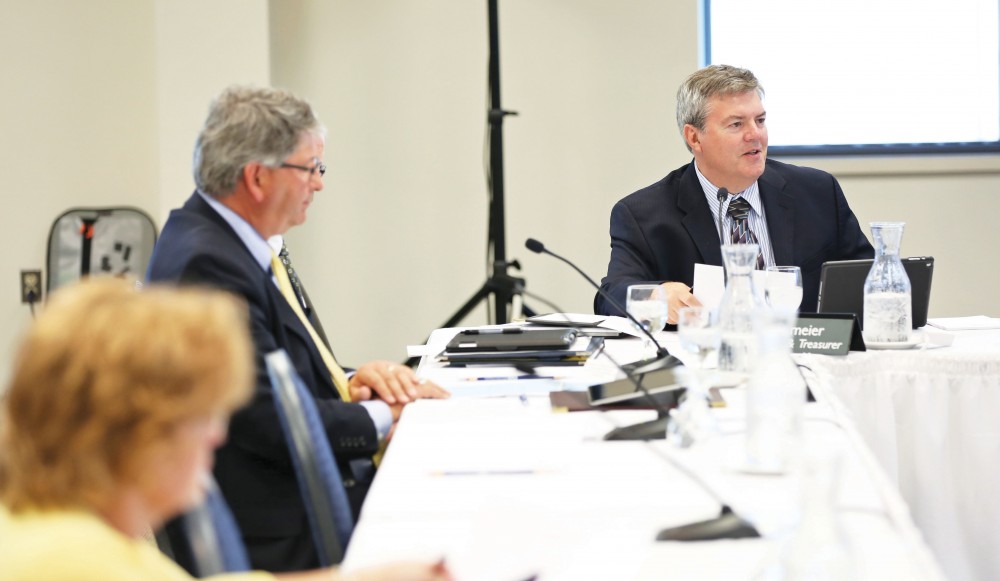Where the money goes

GVL / Kevin Sielaff Jim Bachmeier, Vice President of finance, updates the board on the tuition incerase. The Grand Valley State University Board of Trustees holds a meeting Friday, July 10, 2015, to discuss the 3.0 percentage increase on tuition rates. The motion passed, meaning that Grand Valley students will be paying $163.00 more per semester in tuition.
Sep 24, 2015
At Grand Valley State University, it is common to hear students complaining about things that the university does that they say they are paying for – a prime example is “watering the sidewalks.” Students want to know where their money goes.
“The short answer is that tuition revenue provides more than 80 percent of the university’s general fund revenue,” said Matt McLogan, vice president for university relations. “Tuition is part of nearly every university activity.”
Tuition goes many different places, and the breakdown of tuition is much different than students may think. The setting of tuition and where students money goes is controlled by the finance and administration office.
Jim Bachmeier, the vice president of finance and administration, said that even with inflation, the cost to attend college actually hasn’t changed much over the years, but it’s rather a shift in state aid to public colleges.
“The cost to run a class hasn’t changed much at all over 30 years,” he said. “It’s who’s paying it.”
Between 2008 and 2012 alone, Michigan cut education funding by a third, causing tuition rates to rise substantially. Education funding has been the biggest change in effecting tuition rates over the years. GVSU received $65 million in state appropriations this year, which is directed toward financial aid, debt service and utilities.
Money coming into GVSU goes into different places depending on where it’s coming from. Tuition goes directly into the general fund. Any grants or gifts given to the university go into restricted funds. Money spent on campus, like at the bookstore, goes into an auxiliary fund. The three funds are completely separate from each other.
Auxiliary funds come from any type of campus entity that provides a service for students, and that money goes back into the entity to pay for the cost of service. Restricted funds’ terms are set by the donor, usually to use the money granted or gifted in a certain way, like in scholarship form or only for a specific project. The general fund puts money from tuition into all areas of GVSU.
“It really is our intention that (it) be as transparent as possible,” Bachmeier said. “You guys are paying a lot of money. You have every reason and right to wonder ‘where does it go?’”
The rate of tuition depends on the student’s year, number of credits and where the student is from. For a lower division, full-time student, in-state tuition is $11,078 and out-of-state is $15,744 for the entire year. For a full-time upper division student, in-state tuition is $11,648 and out-of-state is $16,344.
These numbers mean that the average student at GVSU is paying about 41 cents per minute per class. That means for every hour of class skipped, a student is losing $24.60.
With about 25,000 students enrolled at GVSU, tuition totals up to $294.73 million. Including $65 million in state appropriation, adding interest and taking out the $40 million financial aid awarded annually, the university’s total general fund budget revenue is $322.94 million.
The biggest expenditure of the general fund budget is in the academic affairs and student affairs division, with $200 million being spent. This division includes all of the academic colleges on campus such as the College of Liberal Arts and Sciences, which is the biggest college expenditure at $79 million of the $200 million. This division also includes the Student Academic Success Center, the Mary Idema Pew Library and Student Services.
The finance and administration division has the second most money appropriated. This division is comprised of human resources, facilities services and the athletics and Fieldhouse operations and uses $36 million. Information technology and the admissions office are included in the enrollment development division, which uses $24.6 million.
Development and alumni relations is in its own division, as is central administration, using about $7 million and $5.9 million, respectively. The university relations division, including University Communications, WGVU and institutional marketing uses about $6.8 million.
The inclusion and equity division, which includes disability services, affirmative action services and Title IX operations, uses $1.45 million.
Institutional funds, which is a miscellaneous division, includes university insurance, bus services, utilities and construction uses $5.7 million. There is a $10.7 million contingency that is also part of the division, which is money used in the case of any miscalculations.
“It’s the other things. The counseling services, the advising services, the nightlife,” Bachmeier said. “There are people staffing the library and the Fieldhouse. It’s the police department. There’s a lot of stuff going on that I think are really the vibrancy of student life.”
The finance and administration office also has resources on the web that help to clear up and lay out all of GVSU’s expenditures. Tuition breakdown and other general fund information can be found at www.gvsu.edu/s/jg.






















